Literature Review and Critique: Operations Management Fundamentals
VerifiedAdded on 2020/03/07
|12
|2837
|52
Report
AI Summary
This report presents a comprehensive literature review and critique of an article focusing on Operations Management (OM). The review explores the core purpose of OM, which involves converting raw materials and labor into services and goods, emphasizing the integration of logistics, operations, and customer satisfaction to maximize organizational profits. The analysis delves into key research questions concerning OM's domains, functionalities, and its connections with logistics, operations, and customers. The report examines the primary and secondary data used in the article, including data from journals, books, and interviews, highlighting the main inferences and key concepts such as procurement, inventory, and quality management. The assumptions, including the importance of quality, supply chain integration, and customer satisfaction, are critically assessed. Finally, the implications of the OM processes, including the benefits of integrated operations, logistics, and customer focus, are discussed, leading to recommendations for future research and practice. The review underscores the importance of OM for organizational sustainability and the need for efficient cost management.
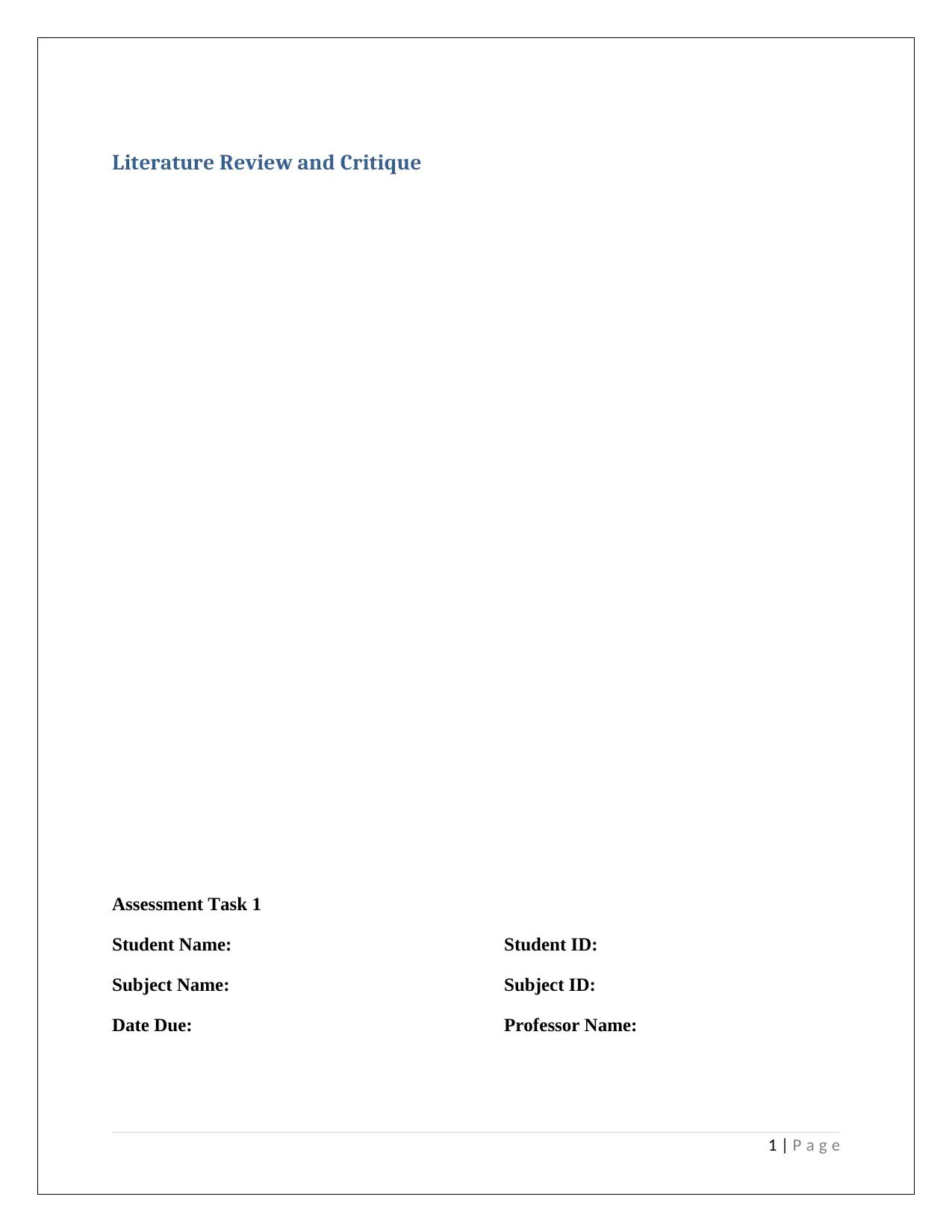
Literature Review and Critique
Assessment Task 1
Student Name: Student ID:
Subject Name: Subject ID:
Date Due: Professor Name:
1 | P a g e
Assessment Task 1
Student Name: Student ID:
Subject Name: Subject ID:
Date Due: Professor Name:
1 | P a g e
Paraphrase This Document
Need a fresh take? Get an instant paraphrase of this document with our AI Paraphraser
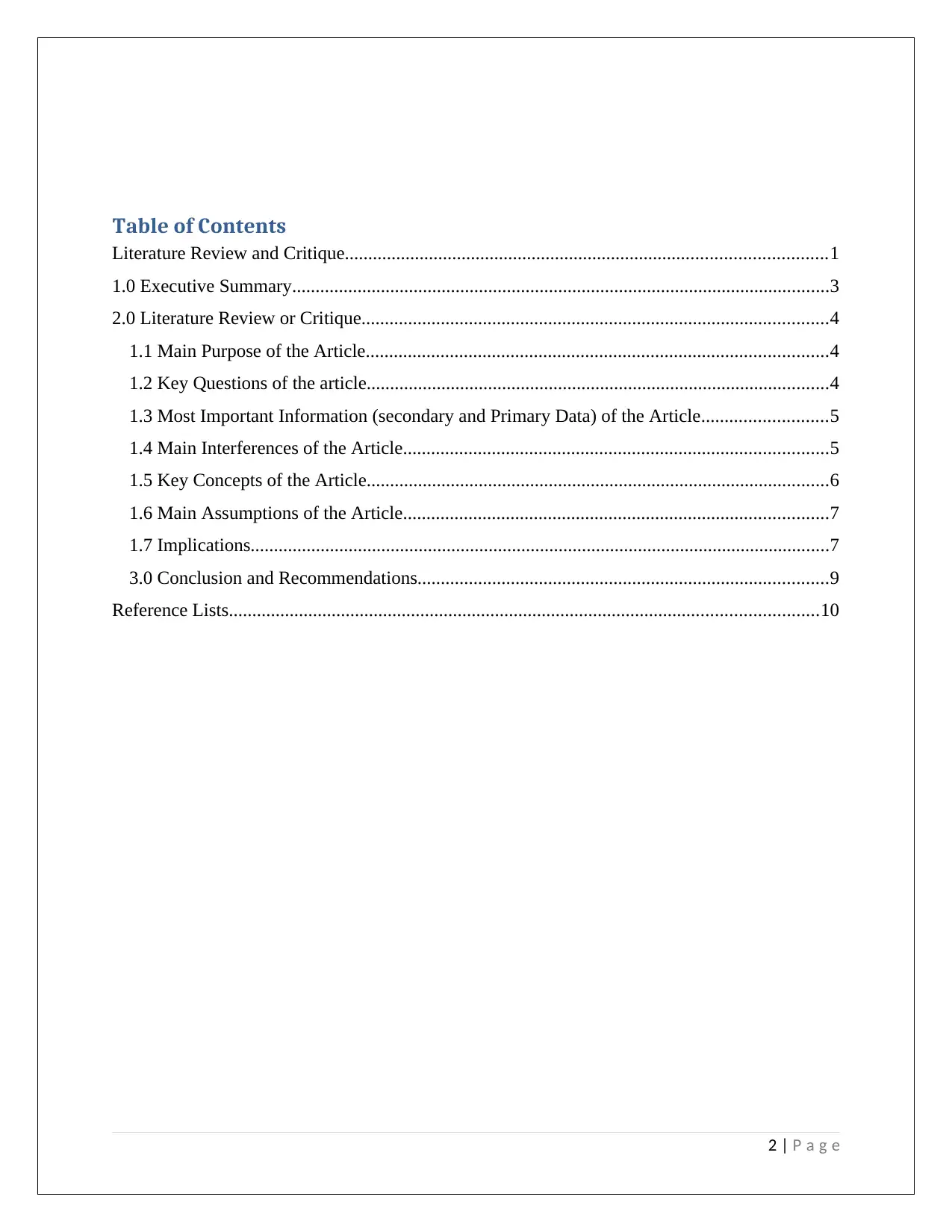
Table of Contents
Literature Review and Critique.......................................................................................................1
1.0 Executive Summary...................................................................................................................3
2.0 Literature Review or Critique....................................................................................................4
1.1 Main Purpose of the Article...................................................................................................4
1.2 Key Questions of the article...................................................................................................4
1.3 Most Important Information (secondary and Primary Data) of the Article...........................5
1.4 Main Interferences of the Article...........................................................................................5
1.5 Key Concepts of the Article...................................................................................................6
1.6 Main Assumptions of the Article...........................................................................................7
1.7 Implications............................................................................................................................7
3.0 Conclusion and Recommendations........................................................................................9
Reference Lists..............................................................................................................................10
2 | P a g e
Literature Review and Critique.......................................................................................................1
1.0 Executive Summary...................................................................................................................3
2.0 Literature Review or Critique....................................................................................................4
1.1 Main Purpose of the Article...................................................................................................4
1.2 Key Questions of the article...................................................................................................4
1.3 Most Important Information (secondary and Primary Data) of the Article...........................5
1.4 Main Interferences of the Article...........................................................................................5
1.5 Key Concepts of the Article...................................................................................................6
1.6 Main Assumptions of the Article...........................................................................................7
1.7 Implications............................................................................................................................7
3.0 Conclusion and Recommendations........................................................................................9
Reference Lists..............................................................................................................................10
2 | P a g e
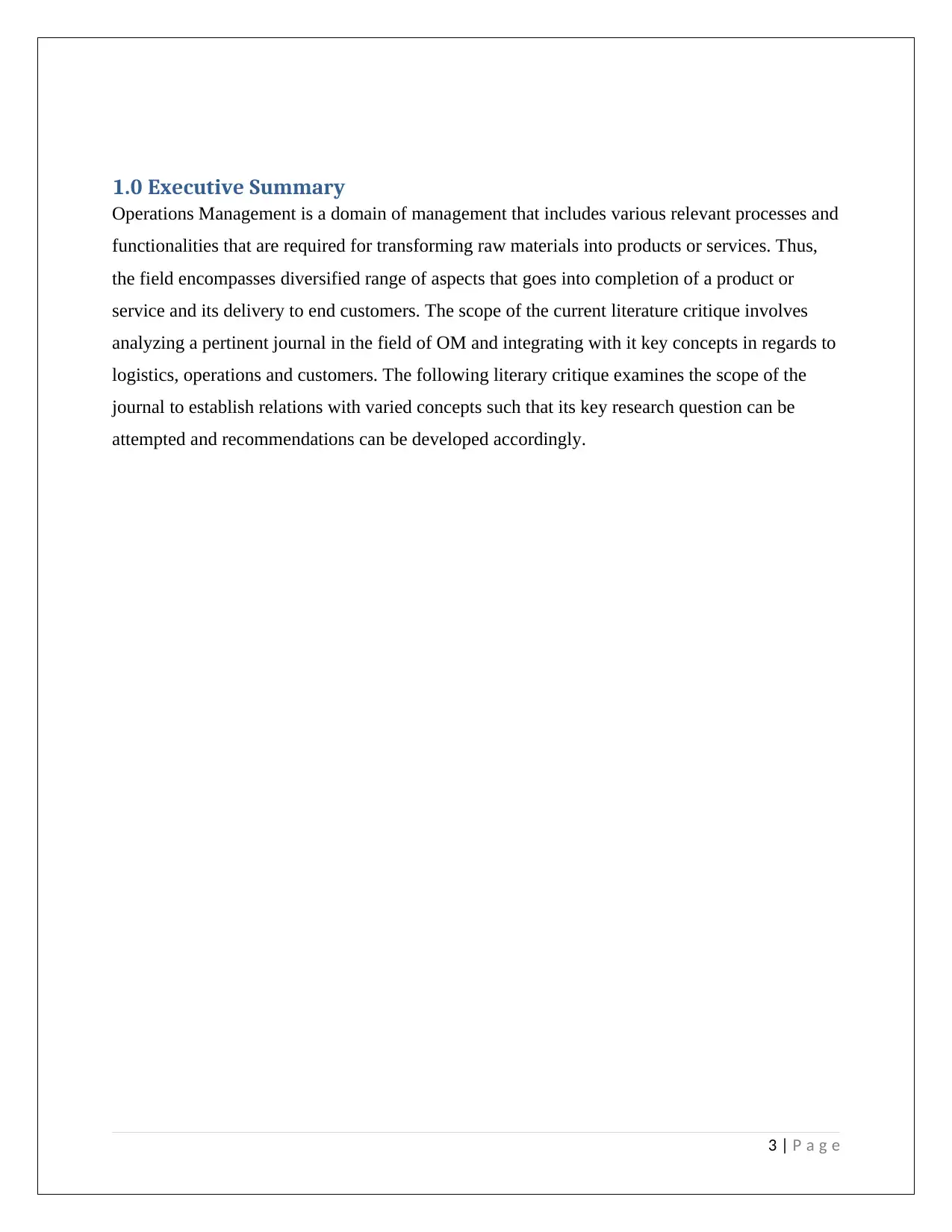
1.0 Executive Summary
Operations Management is a domain of management that includes various relevant processes and
functionalities that are required for transforming raw materials into products or services. Thus,
the field encompasses diversified range of aspects that goes into completion of a product or
service and its delivery to end customers. The scope of the current literature critique involves
analyzing a pertinent journal in the field of OM and integrating with it key concepts in regards to
logistics, operations and customers. The following literary critique examines the scope of the
journal to establish relations with varied concepts such that its key research question can be
attempted and recommendations can be developed accordingly.
3 | P a g e
Operations Management is a domain of management that includes various relevant processes and
functionalities that are required for transforming raw materials into products or services. Thus,
the field encompasses diversified range of aspects that goes into completion of a product or
service and its delivery to end customers. The scope of the current literature critique involves
analyzing a pertinent journal in the field of OM and integrating with it key concepts in regards to
logistics, operations and customers. The following literary critique examines the scope of the
journal to establish relations with varied concepts such that its key research question can be
attempted and recommendations can be developed accordingly.
3 | P a g e
⊘ This is a preview!⊘
Do you want full access?
Subscribe today to unlock all pages.

Trusted by 1+ million students worldwide
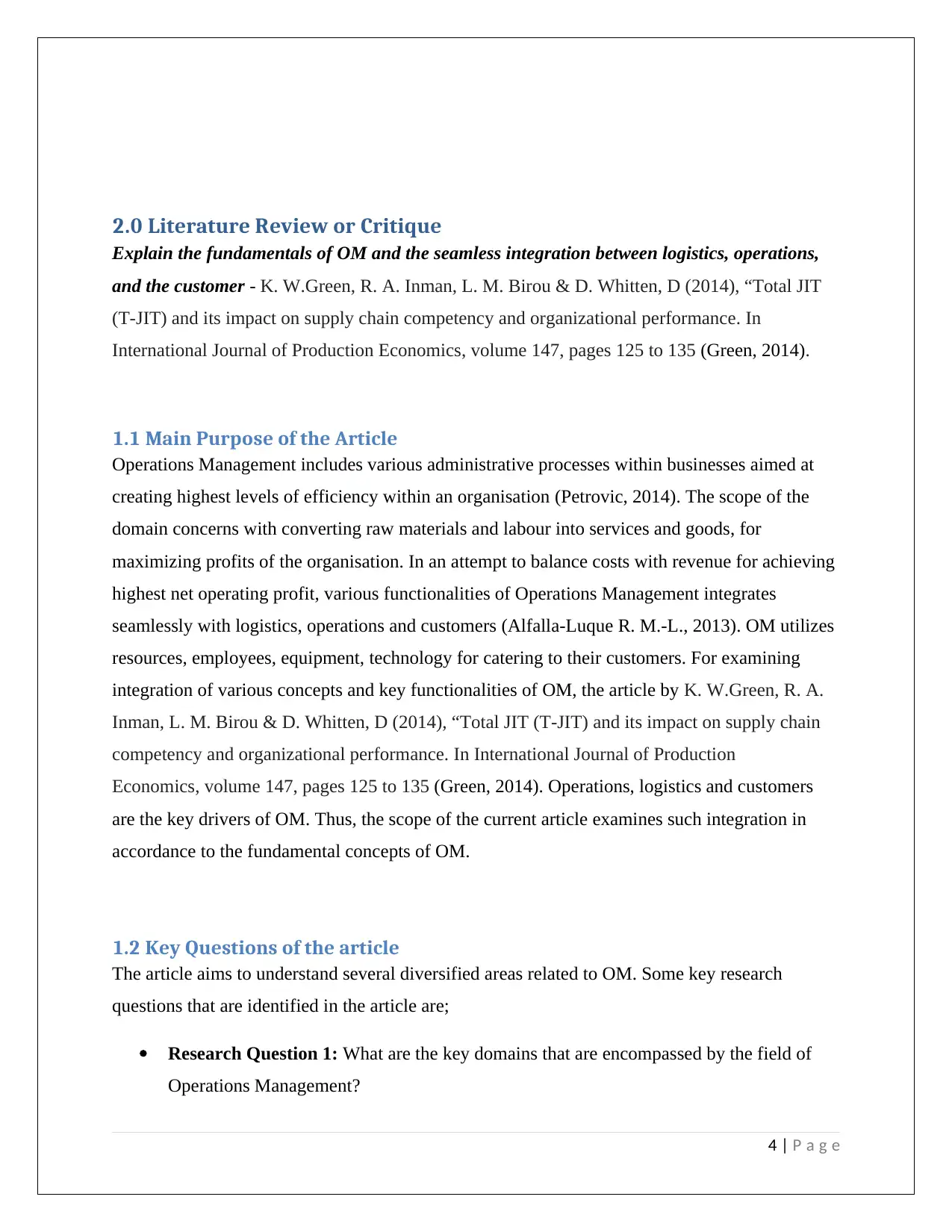
2.0 Literature Review or Critique
Explain the fundamentals of OM and the seamless integration between logistics, operations,
and the customer - K. W.Green, R. A. Inman, L. M. Birou & D. Whitten, D (2014), “Total JIT
(T-JIT) and its impact on supply chain competency and organizational performance. In
International Journal of Production Economics, volume 147, pages 125 to 135 (Green, 2014).
1.1 Main Purpose of the Article
Operations Management includes various administrative processes within businesses aimed at
creating highest levels of efficiency within an organisation (Petrovic, 2014). The scope of the
domain concerns with converting raw materials and labour into services and goods, for
maximizing profits of the organisation. In an attempt to balance costs with revenue for achieving
highest net operating profit, various functionalities of Operations Management integrates
seamlessly with logistics, operations and customers (Alfalla-Luque R. M.-L., 2013). OM utilizes
resources, employees, equipment, technology for catering to their customers. For examining
integration of various concepts and key functionalities of OM, the article by K. W.Green, R. A.
Inman, L. M. Birou & D. Whitten, D (2014), “Total JIT (T-JIT) and its impact on supply chain
competency and organizational performance. In International Journal of Production
Economics, volume 147, pages 125 to 135 (Green, 2014). Operations, logistics and customers
are the key drivers of OM. Thus, the scope of the current article examines such integration in
accordance to the fundamental concepts of OM.
1.2 Key Questions of the article
The article aims to understand several diversified areas related to OM. Some key research
questions that are identified in the article are;
Research Question 1: What are the key domains that are encompassed by the field of
Operations Management?
4 | P a g e
Explain the fundamentals of OM and the seamless integration between logistics, operations,
and the customer - K. W.Green, R. A. Inman, L. M. Birou & D. Whitten, D (2014), “Total JIT
(T-JIT) and its impact on supply chain competency and organizational performance. In
International Journal of Production Economics, volume 147, pages 125 to 135 (Green, 2014).
1.1 Main Purpose of the Article
Operations Management includes various administrative processes within businesses aimed at
creating highest levels of efficiency within an organisation (Petrovic, 2014). The scope of the
domain concerns with converting raw materials and labour into services and goods, for
maximizing profits of the organisation. In an attempt to balance costs with revenue for achieving
highest net operating profit, various functionalities of Operations Management integrates
seamlessly with logistics, operations and customers (Alfalla-Luque R. M.-L., 2013). OM utilizes
resources, employees, equipment, technology for catering to their customers. For examining
integration of various concepts and key functionalities of OM, the article by K. W.Green, R. A.
Inman, L. M. Birou & D. Whitten, D (2014), “Total JIT (T-JIT) and its impact on supply chain
competency and organizational performance. In International Journal of Production
Economics, volume 147, pages 125 to 135 (Green, 2014). Operations, logistics and customers
are the key drivers of OM. Thus, the scope of the current article examines such integration in
accordance to the fundamental concepts of OM.
1.2 Key Questions of the article
The article aims to understand several diversified areas related to OM. Some key research
questions that are identified in the article are;
Research Question 1: What are the key domains that are encompassed by the field of
Operations Management?
4 | P a g e
Paraphrase This Document
Need a fresh take? Get an instant paraphrase of this document with our AI Paraphraser
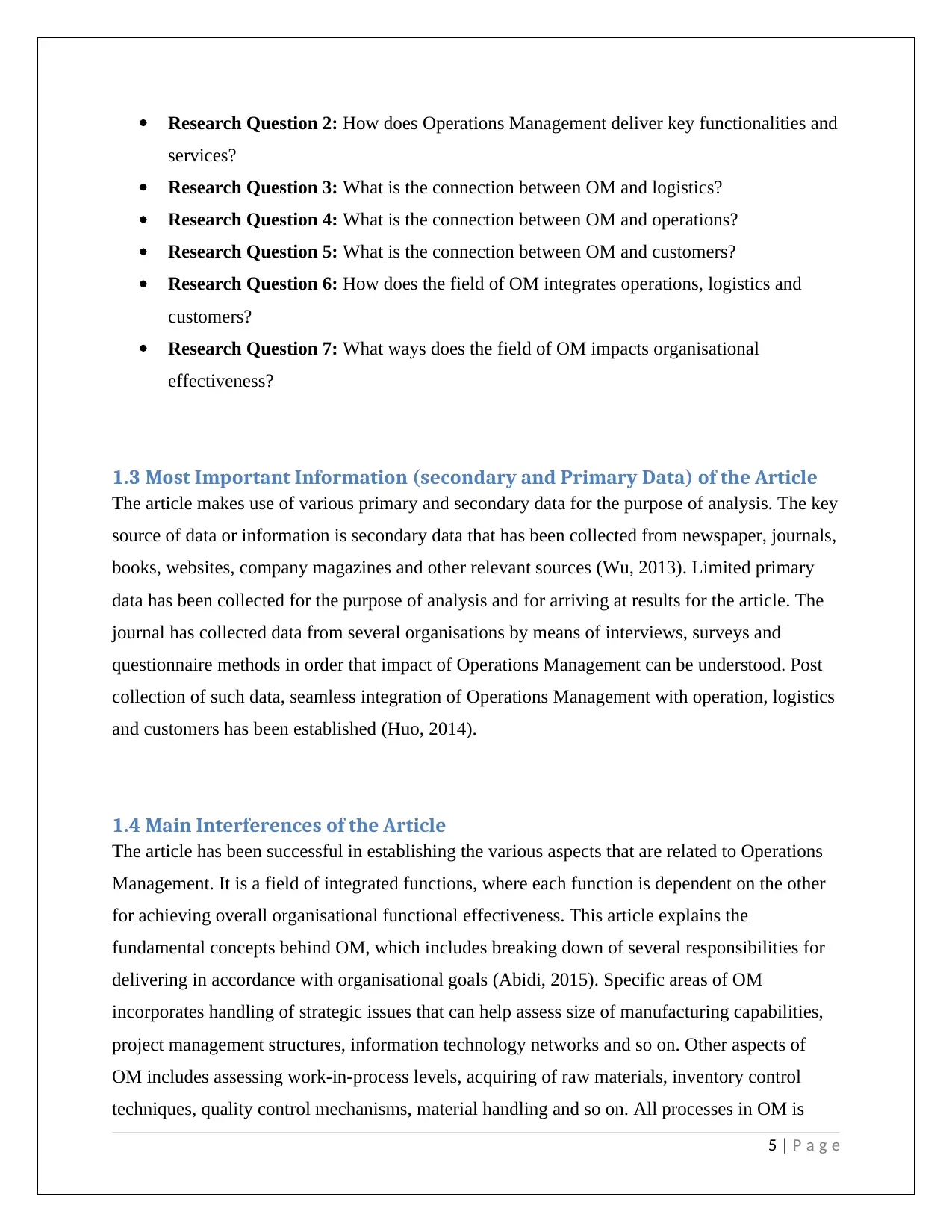
Research Question 2: How does Operations Management deliver key functionalities and
services?
Research Question 3: What is the connection between OM and logistics?
Research Question 4: What is the connection between OM and operations?
Research Question 5: What is the connection between OM and customers?
Research Question 6: How does the field of OM integrates operations, logistics and
customers?
Research Question 7: What ways does the field of OM impacts organisational
effectiveness?
1.3 Most Important Information (secondary and Primary Data) of the Article
The article makes use of various primary and secondary data for the purpose of analysis. The key
source of data or information is secondary data that has been collected from newspaper, journals,
books, websites, company magazines and other relevant sources (Wu, 2013). Limited primary
data has been collected for the purpose of analysis and for arriving at results for the article. The
journal has collected data from several organisations by means of interviews, surveys and
questionnaire methods in order that impact of Operations Management can be understood. Post
collection of such data, seamless integration of Operations Management with operation, logistics
and customers has been established (Huo, 2014).
1.4 Main Interferences of the Article
The article has been successful in establishing the various aspects that are related to Operations
Management. It is a field of integrated functions, where each function is dependent on the other
for achieving overall organisational functional effectiveness. This article explains the
fundamental concepts behind OM, which includes breaking down of several responsibilities for
delivering in accordance with organisational goals (Abidi, 2015). Specific areas of OM
incorporates handling of strategic issues that can help assess size of manufacturing capabilities,
project management structures, information technology networks and so on. Other aspects of
OM includes assessing work-in-process levels, acquiring of raw materials, inventory control
techniques, quality control mechanisms, material handling and so on. All processes in OM is
5 | P a g e
services?
Research Question 3: What is the connection between OM and logistics?
Research Question 4: What is the connection between OM and operations?
Research Question 5: What is the connection between OM and customers?
Research Question 6: How does the field of OM integrates operations, logistics and
customers?
Research Question 7: What ways does the field of OM impacts organisational
effectiveness?
1.3 Most Important Information (secondary and Primary Data) of the Article
The article makes use of various primary and secondary data for the purpose of analysis. The key
source of data or information is secondary data that has been collected from newspaper, journals,
books, websites, company magazines and other relevant sources (Wu, 2013). Limited primary
data has been collected for the purpose of analysis and for arriving at results for the article. The
journal has collected data from several organisations by means of interviews, surveys and
questionnaire methods in order that impact of Operations Management can be understood. Post
collection of such data, seamless integration of Operations Management with operation, logistics
and customers has been established (Huo, 2014).
1.4 Main Interferences of the Article
The article has been successful in establishing the various aspects that are related to Operations
Management. It is a field of integrated functions, where each function is dependent on the other
for achieving overall organisational functional effectiveness. This article explains the
fundamental concepts behind OM, which includes breaking down of several responsibilities for
delivering in accordance with organisational goals (Abidi, 2015). Specific areas of OM
incorporates handling of strategic issues that can help assess size of manufacturing capabilities,
project management structures, information technology networks and so on. Other aspects of
OM includes assessing work-in-process levels, acquiring of raw materials, inventory control
techniques, quality control mechanisms, material handling and so on. All processes in OM is
5 | P a g e
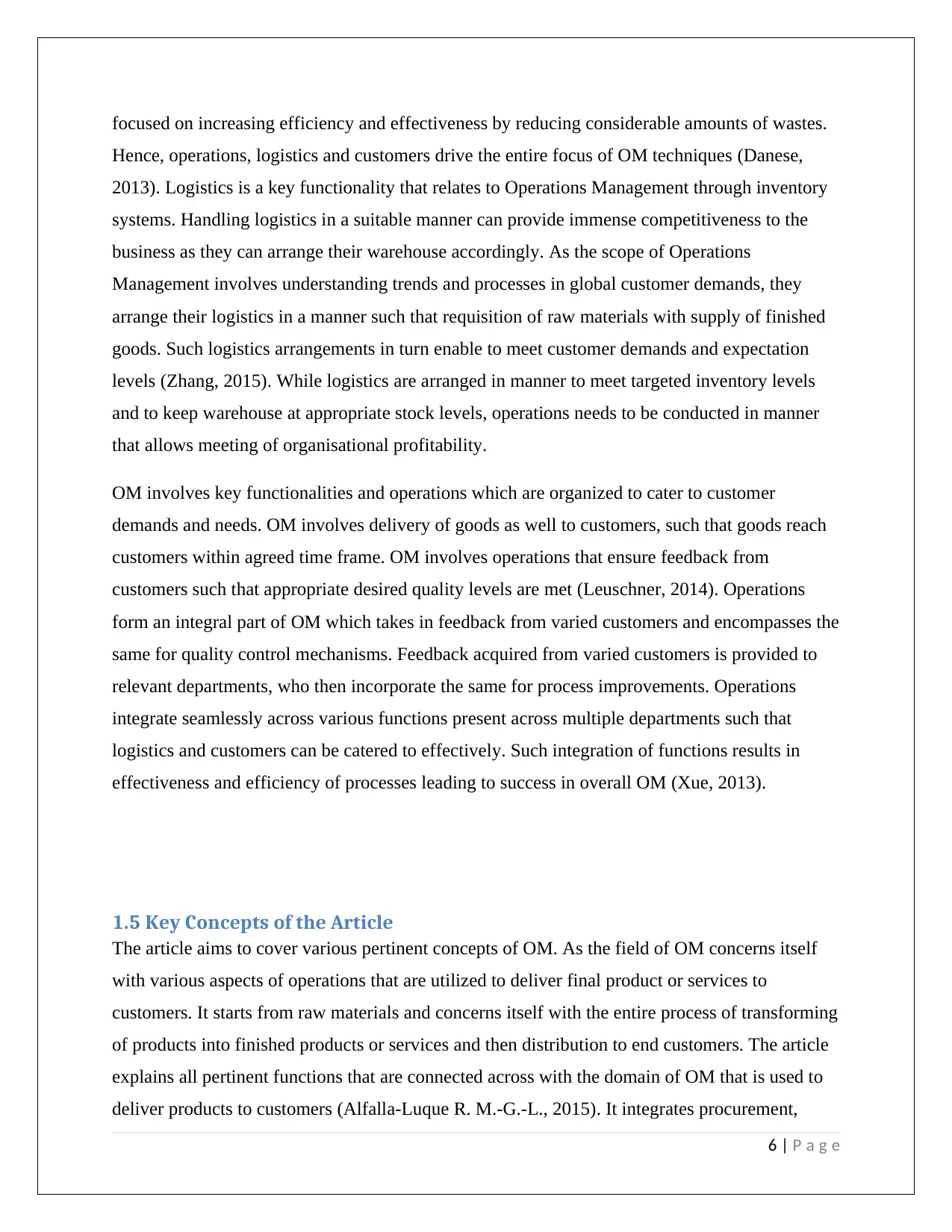
focused on increasing efficiency and effectiveness by reducing considerable amounts of wastes.
Hence, operations, logistics and customers drive the entire focus of OM techniques (Danese,
2013). Logistics is a key functionality that relates to Operations Management through inventory
systems. Handling logistics in a suitable manner can provide immense competitiveness to the
business as they can arrange their warehouse accordingly. As the scope of Operations
Management involves understanding trends and processes in global customer demands, they
arrange their logistics in a manner such that requisition of raw materials with supply of finished
goods. Such logistics arrangements in turn enable to meet customer demands and expectation
levels (Zhang, 2015). While logistics are arranged in manner to meet targeted inventory levels
and to keep warehouse at appropriate stock levels, operations needs to be conducted in manner
that allows meeting of organisational profitability.
OM involves key functionalities and operations which are organized to cater to customer
demands and needs. OM involves delivery of goods as well to customers, such that goods reach
customers within agreed time frame. OM involves operations that ensure feedback from
customers such that appropriate desired quality levels are met (Leuschner, 2014). Operations
form an integral part of OM which takes in feedback from varied customers and encompasses the
same for quality control mechanisms. Feedback acquired from varied customers is provided to
relevant departments, who then incorporate the same for process improvements. Operations
integrate seamlessly across various functions present across multiple departments such that
logistics and customers can be catered to effectively. Such integration of functions results in
effectiveness and efficiency of processes leading to success in overall OM (Xue, 2013).
1.5 Key Concepts of the Article
The article aims to cover various pertinent concepts of OM. As the field of OM concerns itself
with various aspects of operations that are utilized to deliver final product or services to
customers. It starts from raw materials and concerns itself with the entire process of transforming
of products into finished products or services and then distribution to end customers. The article
explains all pertinent functions that are connected across with the domain of OM that is used to
deliver products to customers (Alfalla-Luque R. M.-G.-L., 2015). It integrates procurement,
6 | P a g e
Hence, operations, logistics and customers drive the entire focus of OM techniques (Danese,
2013). Logistics is a key functionality that relates to Operations Management through inventory
systems. Handling logistics in a suitable manner can provide immense competitiveness to the
business as they can arrange their warehouse accordingly. As the scope of Operations
Management involves understanding trends and processes in global customer demands, they
arrange their logistics in a manner such that requisition of raw materials with supply of finished
goods. Such logistics arrangements in turn enable to meet customer demands and expectation
levels (Zhang, 2015). While logistics are arranged in manner to meet targeted inventory levels
and to keep warehouse at appropriate stock levels, operations needs to be conducted in manner
that allows meeting of organisational profitability.
OM involves key functionalities and operations which are organized to cater to customer
demands and needs. OM involves delivery of goods as well to customers, such that goods reach
customers within agreed time frame. OM involves operations that ensure feedback from
customers such that appropriate desired quality levels are met (Leuschner, 2014). Operations
form an integral part of OM which takes in feedback from varied customers and encompasses the
same for quality control mechanisms. Feedback acquired from varied customers is provided to
relevant departments, who then incorporate the same for process improvements. Operations
integrate seamlessly across various functions present across multiple departments such that
logistics and customers can be catered to effectively. Such integration of functions results in
effectiveness and efficiency of processes leading to success in overall OM (Xue, 2013).
1.5 Key Concepts of the Article
The article aims to cover various pertinent concepts of OM. As the field of OM concerns itself
with various aspects of operations that are utilized to deliver final product or services to
customers. It starts from raw materials and concerns itself with the entire process of transforming
of products into finished products or services and then distribution to end customers. The article
explains all pertinent functions that are connected across with the domain of OM that is used to
deliver products to customers (Alfalla-Luque R. M.-G.-L., 2015). It integrates procurement,
6 | P a g e
⊘ This is a preview!⊘
Do you want full access?
Subscribe today to unlock all pages.

Trusted by 1+ million students worldwide
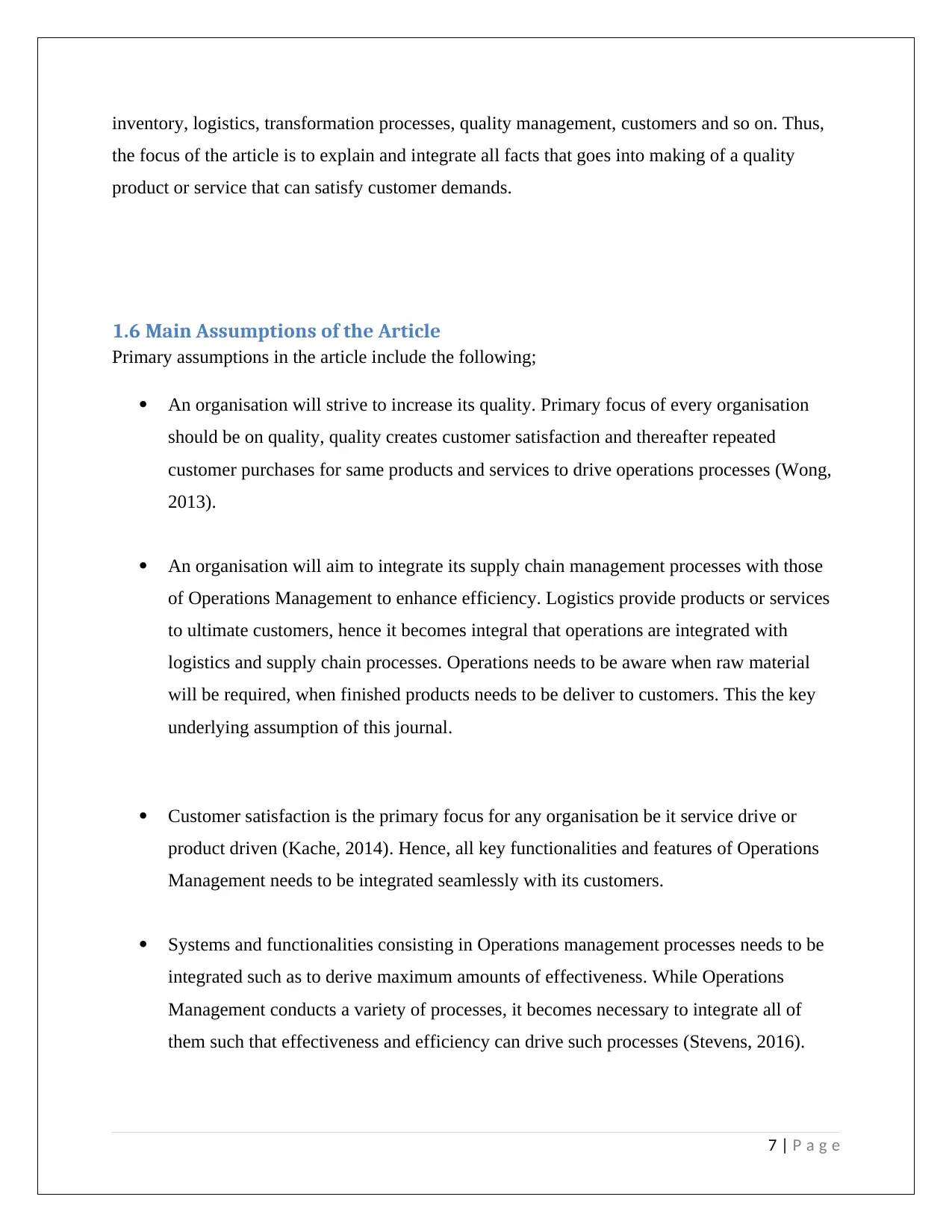
inventory, logistics, transformation processes, quality management, customers and so on. Thus,
the focus of the article is to explain and integrate all facts that goes into making of a quality
product or service that can satisfy customer demands.
1.6 Main Assumptions of the Article
Primary assumptions in the article include the following;
An organisation will strive to increase its quality. Primary focus of every organisation
should be on quality, quality creates customer satisfaction and thereafter repeated
customer purchases for same products and services to drive operations processes (Wong,
2013).
An organisation will aim to integrate its supply chain management processes with those
of Operations Management to enhance efficiency. Logistics provide products or services
to ultimate customers, hence it becomes integral that operations are integrated with
logistics and supply chain processes. Operations needs to be aware when raw material
will be required, when finished products needs to be deliver to customers. This the key
underlying assumption of this journal.
Customer satisfaction is the primary focus for any organisation be it service drive or
product driven (Kache, 2014). Hence, all key functionalities and features of Operations
Management needs to be integrated seamlessly with its customers.
Systems and functionalities consisting in Operations management processes needs to be
integrated such as to derive maximum amounts of effectiveness. While Operations
Management conducts a variety of processes, it becomes necessary to integrate all of
them such that effectiveness and efficiency can drive such processes (Stevens, 2016).
7 | P a g e
the focus of the article is to explain and integrate all facts that goes into making of a quality
product or service that can satisfy customer demands.
1.6 Main Assumptions of the Article
Primary assumptions in the article include the following;
An organisation will strive to increase its quality. Primary focus of every organisation
should be on quality, quality creates customer satisfaction and thereafter repeated
customer purchases for same products and services to drive operations processes (Wong,
2013).
An organisation will aim to integrate its supply chain management processes with those
of Operations Management to enhance efficiency. Logistics provide products or services
to ultimate customers, hence it becomes integral that operations are integrated with
logistics and supply chain processes. Operations needs to be aware when raw material
will be required, when finished products needs to be deliver to customers. This the key
underlying assumption of this journal.
Customer satisfaction is the primary focus for any organisation be it service drive or
product driven (Kache, 2014). Hence, all key functionalities and features of Operations
Management needs to be integrated seamlessly with its customers.
Systems and functionalities consisting in Operations management processes needs to be
integrated such as to derive maximum amounts of effectiveness. While Operations
Management conducts a variety of processes, it becomes necessary to integrate all of
them such that effectiveness and efficiency can drive such processes (Stevens, 2016).
7 | P a g e
Paraphrase This Document
Need a fresh take? Get an instant paraphrase of this document with our AI Paraphraser
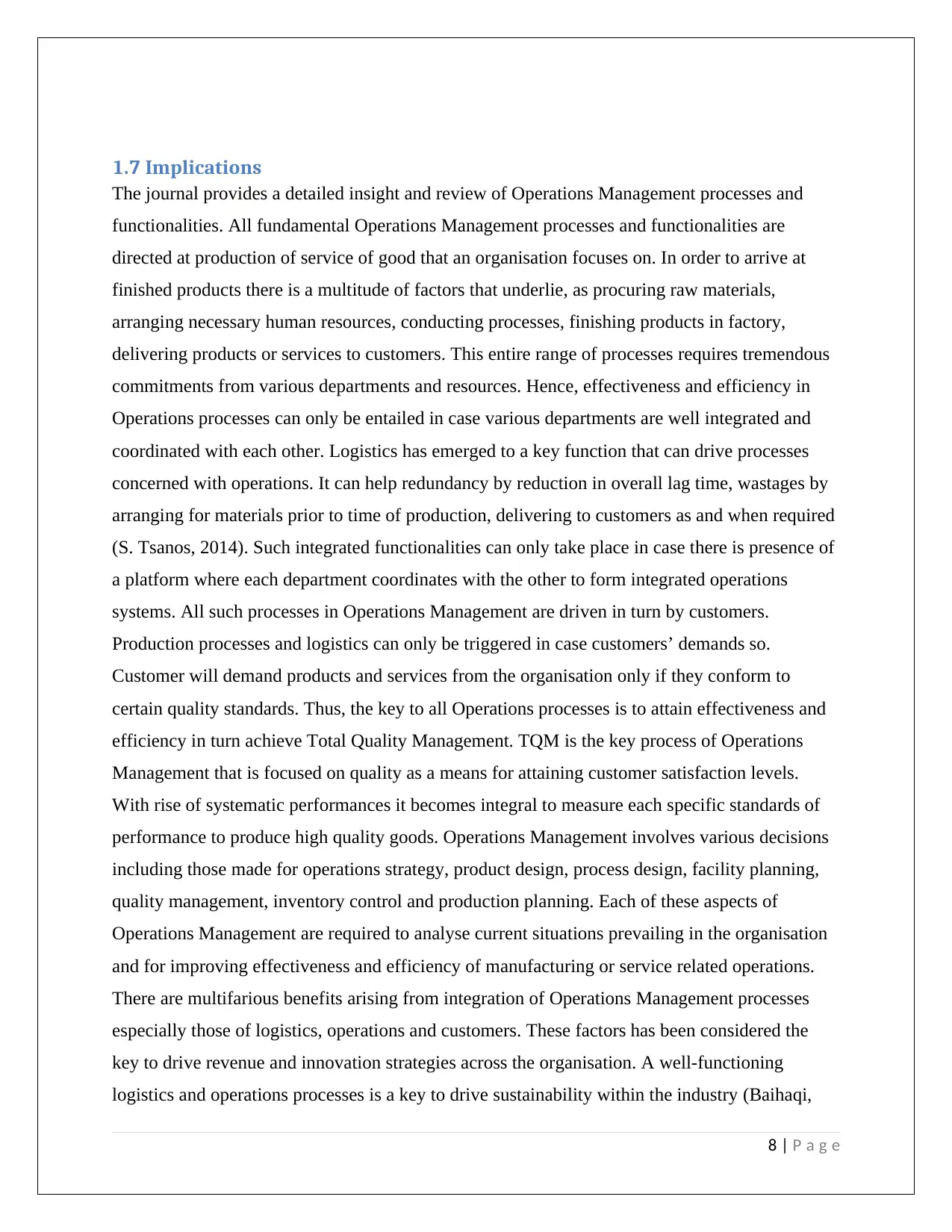
1.7 Implications
The journal provides a detailed insight and review of Operations Management processes and
functionalities. All fundamental Operations Management processes and functionalities are
directed at production of service of good that an organisation focuses on. In order to arrive at
finished products there is a multitude of factors that underlie, as procuring raw materials,
arranging necessary human resources, conducting processes, finishing products in factory,
delivering products or services to customers. This entire range of processes requires tremendous
commitments from various departments and resources. Hence, effectiveness and efficiency in
Operations processes can only be entailed in case various departments are well integrated and
coordinated with each other. Logistics has emerged to a key function that can drive processes
concerned with operations. It can help redundancy by reduction in overall lag time, wastages by
arranging for materials prior to time of production, delivering to customers as and when required
(S. Tsanos, 2014). Such integrated functionalities can only take place in case there is presence of
a platform where each department coordinates with the other to form integrated operations
systems. All such processes in Operations Management are driven in turn by customers.
Production processes and logistics can only be triggered in case customers’ demands so.
Customer will demand products and services from the organisation only if they conform to
certain quality standards. Thus, the key to all Operations processes is to attain effectiveness and
efficiency in turn achieve Total Quality Management. TQM is the key process of Operations
Management that is focused on quality as a means for attaining customer satisfaction levels.
With rise of systematic performances it becomes integral to measure each specific standards of
performance to produce high quality goods. Operations Management involves various decisions
including those made for operations strategy, product design, process design, facility planning,
quality management, inventory control and production planning. Each of these aspects of
Operations Management are required to analyse current situations prevailing in the organisation
and for improving effectiveness and efficiency of manufacturing or service related operations.
There are multifarious benefits arising from integration of Operations Management processes
especially those of logistics, operations and customers. These factors has been considered the
key to drive revenue and innovation strategies across the organisation. A well-functioning
logistics and operations processes is a key to drive sustainability within the industry (Baihaqi,
8 | P a g e
The journal provides a detailed insight and review of Operations Management processes and
functionalities. All fundamental Operations Management processes and functionalities are
directed at production of service of good that an organisation focuses on. In order to arrive at
finished products there is a multitude of factors that underlie, as procuring raw materials,
arranging necessary human resources, conducting processes, finishing products in factory,
delivering products or services to customers. This entire range of processes requires tremendous
commitments from various departments and resources. Hence, effectiveness and efficiency in
Operations processes can only be entailed in case various departments are well integrated and
coordinated with each other. Logistics has emerged to a key function that can drive processes
concerned with operations. It can help redundancy by reduction in overall lag time, wastages by
arranging for materials prior to time of production, delivering to customers as and when required
(S. Tsanos, 2014). Such integrated functionalities can only take place in case there is presence of
a platform where each department coordinates with the other to form integrated operations
systems. All such processes in Operations Management are driven in turn by customers.
Production processes and logistics can only be triggered in case customers’ demands so.
Customer will demand products and services from the organisation only if they conform to
certain quality standards. Thus, the key to all Operations processes is to attain effectiveness and
efficiency in turn achieve Total Quality Management. TQM is the key process of Operations
Management that is focused on quality as a means for attaining customer satisfaction levels.
With rise of systematic performances it becomes integral to measure each specific standards of
performance to produce high quality goods. Operations Management involves various decisions
including those made for operations strategy, product design, process design, facility planning,
quality management, inventory control and production planning. Each of these aspects of
Operations Management are required to analyse current situations prevailing in the organisation
and for improving effectiveness and efficiency of manufacturing or service related operations.
There are multifarious benefits arising from integration of Operations Management processes
especially those of logistics, operations and customers. These factors has been considered the
key to drive revenue and innovation strategies across the organisation. A well-functioning
logistics and operations processes is a key to drive sustainability within the industry (Baihaqi,
8 | P a g e
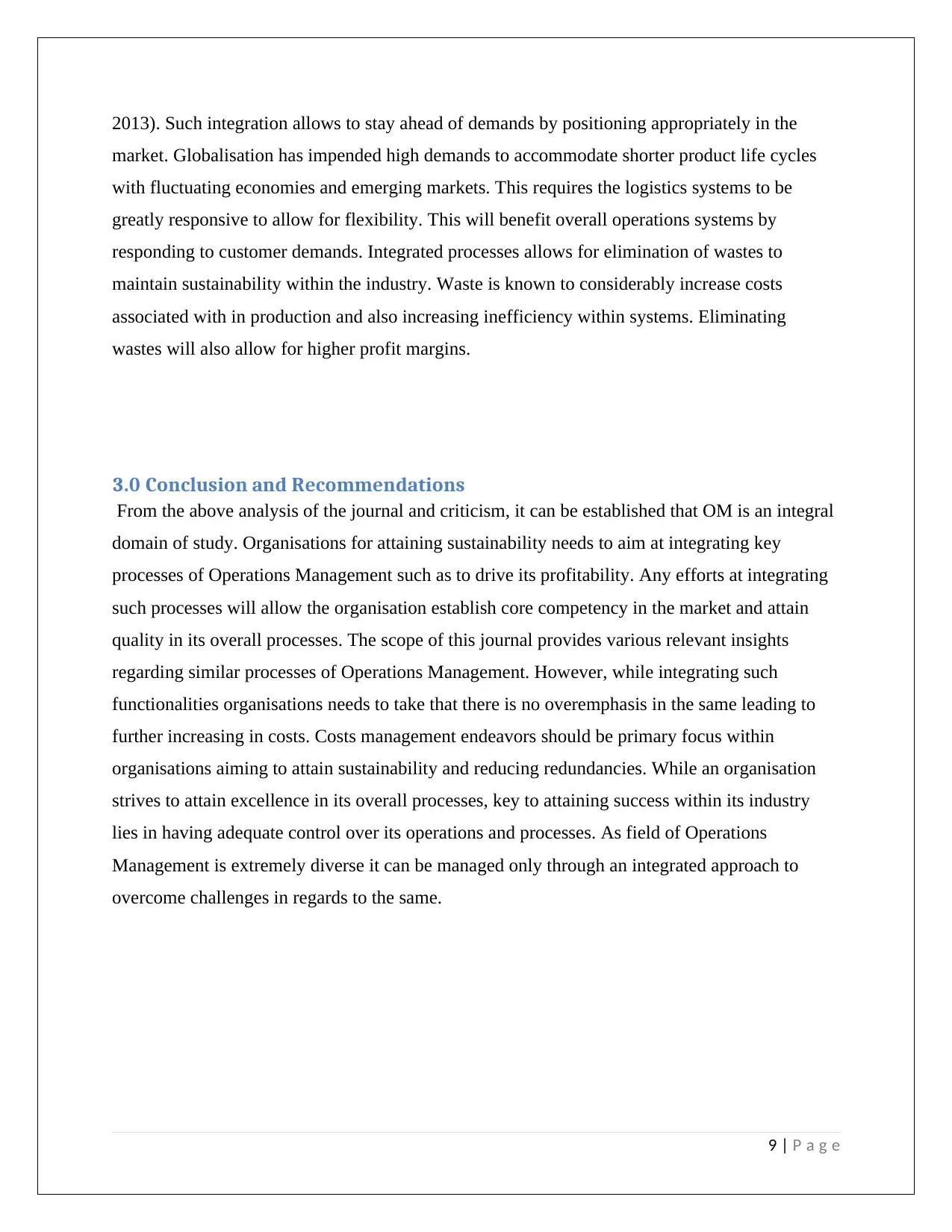
2013). Such integration allows to stay ahead of demands by positioning appropriately in the
market. Globalisation has impended high demands to accommodate shorter product life cycles
with fluctuating economies and emerging markets. This requires the logistics systems to be
greatly responsive to allow for flexibility. This will benefit overall operations systems by
responding to customer demands. Integrated processes allows for elimination of wastes to
maintain sustainability within the industry. Waste is known to considerably increase costs
associated with in production and also increasing inefficiency within systems. Eliminating
wastes will also allow for higher profit margins.
3.0 Conclusion and Recommendations
From the above analysis of the journal and criticism, it can be established that OM is an integral
domain of study. Organisations for attaining sustainability needs to aim at integrating key
processes of Operations Management such as to drive its profitability. Any efforts at integrating
such processes will allow the organisation establish core competency in the market and attain
quality in its overall processes. The scope of this journal provides various relevant insights
regarding similar processes of Operations Management. However, while integrating such
functionalities organisations needs to take that there is no overemphasis in the same leading to
further increasing in costs. Costs management endeavors should be primary focus within
organisations aiming to attain sustainability and reducing redundancies. While an organisation
strives to attain excellence in its overall processes, key to attaining success within its industry
lies in having adequate control over its operations and processes. As field of Operations
Management is extremely diverse it can be managed only through an integrated approach to
overcome challenges in regards to the same.
9 | P a g e
market. Globalisation has impended high demands to accommodate shorter product life cycles
with fluctuating economies and emerging markets. This requires the logistics systems to be
greatly responsive to allow for flexibility. This will benefit overall operations systems by
responding to customer demands. Integrated processes allows for elimination of wastes to
maintain sustainability within the industry. Waste is known to considerably increase costs
associated with in production and also increasing inefficiency within systems. Eliminating
wastes will also allow for higher profit margins.
3.0 Conclusion and Recommendations
From the above analysis of the journal and criticism, it can be established that OM is an integral
domain of study. Organisations for attaining sustainability needs to aim at integrating key
processes of Operations Management such as to drive its profitability. Any efforts at integrating
such processes will allow the organisation establish core competency in the market and attain
quality in its overall processes. The scope of this journal provides various relevant insights
regarding similar processes of Operations Management. However, while integrating such
functionalities organisations needs to take that there is no overemphasis in the same leading to
further increasing in costs. Costs management endeavors should be primary focus within
organisations aiming to attain sustainability and reducing redundancies. While an organisation
strives to attain excellence in its overall processes, key to attaining success within its industry
lies in having adequate control over its operations and processes. As field of Operations
Management is extremely diverse it can be managed only through an integrated approach to
overcome challenges in regards to the same.
9 | P a g e
⊘ This is a preview!⊘
Do you want full access?
Subscribe today to unlock all pages.

Trusted by 1+ million students worldwide
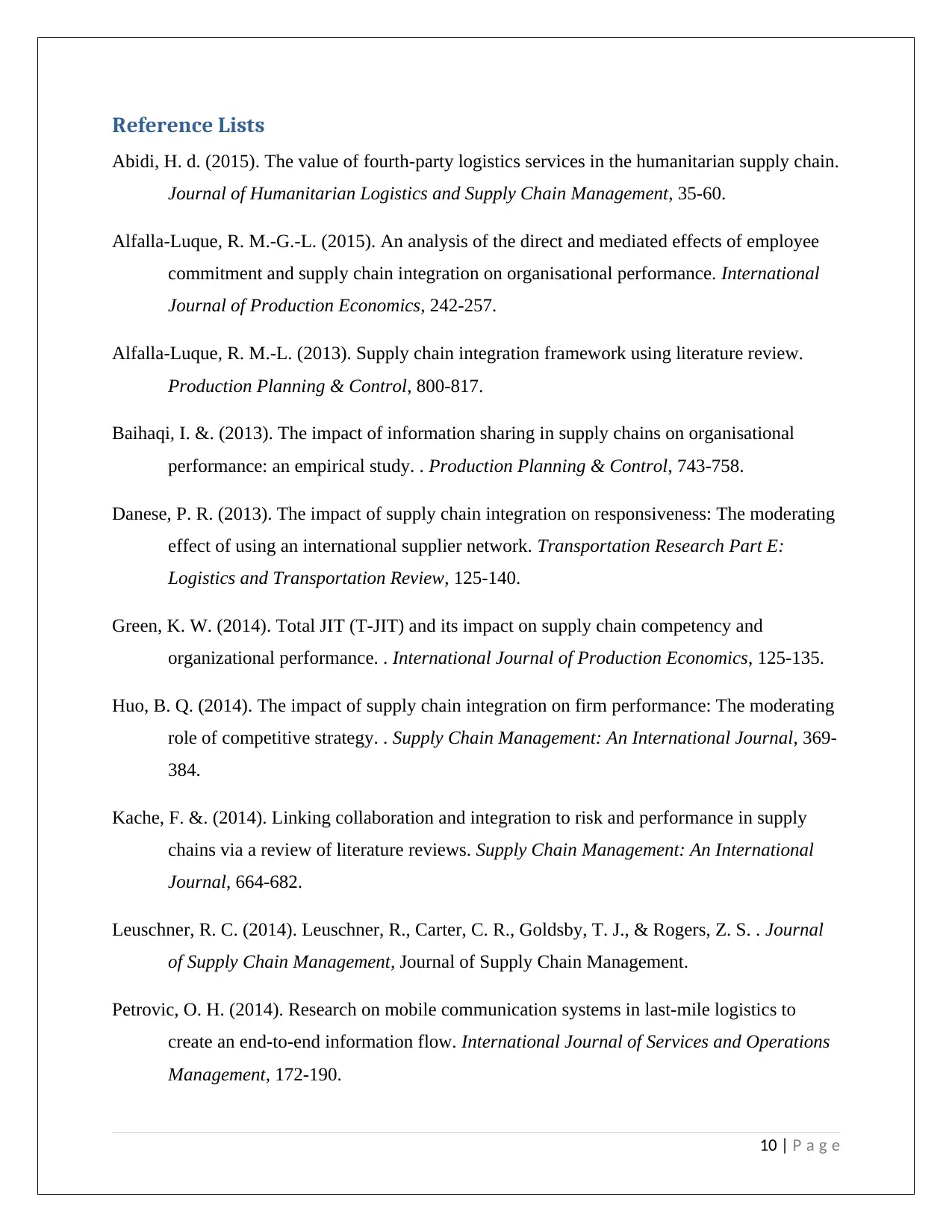
Reference Lists
Abidi, H. d. (2015). The value of fourth-party logistics services in the humanitarian supply chain.
Journal of Humanitarian Logistics and Supply Chain Management, 35-60.
Alfalla-Luque, R. M.-G.-L. (2015). An analysis of the direct and mediated effects of employee
commitment and supply chain integration on organisational performance. International
Journal of Production Economics, 242-257.
Alfalla-Luque, R. M.-L. (2013). Supply chain integration framework using literature review.
Production Planning & Control, 800-817.
Baihaqi, I. &. (2013). The impact of information sharing in supply chains on organisational
performance: an empirical study. . Production Planning & Control, 743-758.
Danese, P. R. (2013). The impact of supply chain integration on responsiveness: The moderating
effect of using an international supplier network. Transportation Research Part E:
Logistics and Transportation Review, 125-140.
Green, K. W. (2014). Total JIT (T-JIT) and its impact on supply chain competency and
organizational performance. . International Journal of Production Economics, 125-135.
Huo, B. Q. (2014). The impact of supply chain integration on firm performance: The moderating
role of competitive strategy. . Supply Chain Management: An International Journal, 369-
384.
Kache, F. &. (2014). Linking collaboration and integration to risk and performance in supply
chains via a review of literature reviews. Supply Chain Management: An International
Journal, 664-682.
Leuschner, R. C. (2014). Leuschner, R., Carter, C. R., Goldsby, T. J., & Rogers, Z. S. . Journal
of Supply Chain Management, Journal of Supply Chain Management.
Petrovic, O. H. (2014). Research on mobile communication systems in last-mile logistics to
create an end-to-end information flow. International Journal of Services and Operations
Management, 172-190.
10 | P a g e
Abidi, H. d. (2015). The value of fourth-party logistics services in the humanitarian supply chain.
Journal of Humanitarian Logistics and Supply Chain Management, 35-60.
Alfalla-Luque, R. M.-G.-L. (2015). An analysis of the direct and mediated effects of employee
commitment and supply chain integration on organisational performance. International
Journal of Production Economics, 242-257.
Alfalla-Luque, R. M.-L. (2013). Supply chain integration framework using literature review.
Production Planning & Control, 800-817.
Baihaqi, I. &. (2013). The impact of information sharing in supply chains on organisational
performance: an empirical study. . Production Planning & Control, 743-758.
Danese, P. R. (2013). The impact of supply chain integration on responsiveness: The moderating
effect of using an international supplier network. Transportation Research Part E:
Logistics and Transportation Review, 125-140.
Green, K. W. (2014). Total JIT (T-JIT) and its impact on supply chain competency and
organizational performance. . International Journal of Production Economics, 125-135.
Huo, B. Q. (2014). The impact of supply chain integration on firm performance: The moderating
role of competitive strategy. . Supply Chain Management: An International Journal, 369-
384.
Kache, F. &. (2014). Linking collaboration and integration to risk and performance in supply
chains via a review of literature reviews. Supply Chain Management: An International
Journal, 664-682.
Leuschner, R. C. (2014). Leuschner, R., Carter, C. R., Goldsby, T. J., & Rogers, Z. S. . Journal
of Supply Chain Management, Journal of Supply Chain Management.
Petrovic, O. H. (2014). Research on mobile communication systems in last-mile logistics to
create an end-to-end information flow. International Journal of Services and Operations
Management, 172-190.
10 | P a g e
Paraphrase This Document
Need a fresh take? Get an instant paraphrase of this document with our AI Paraphraser
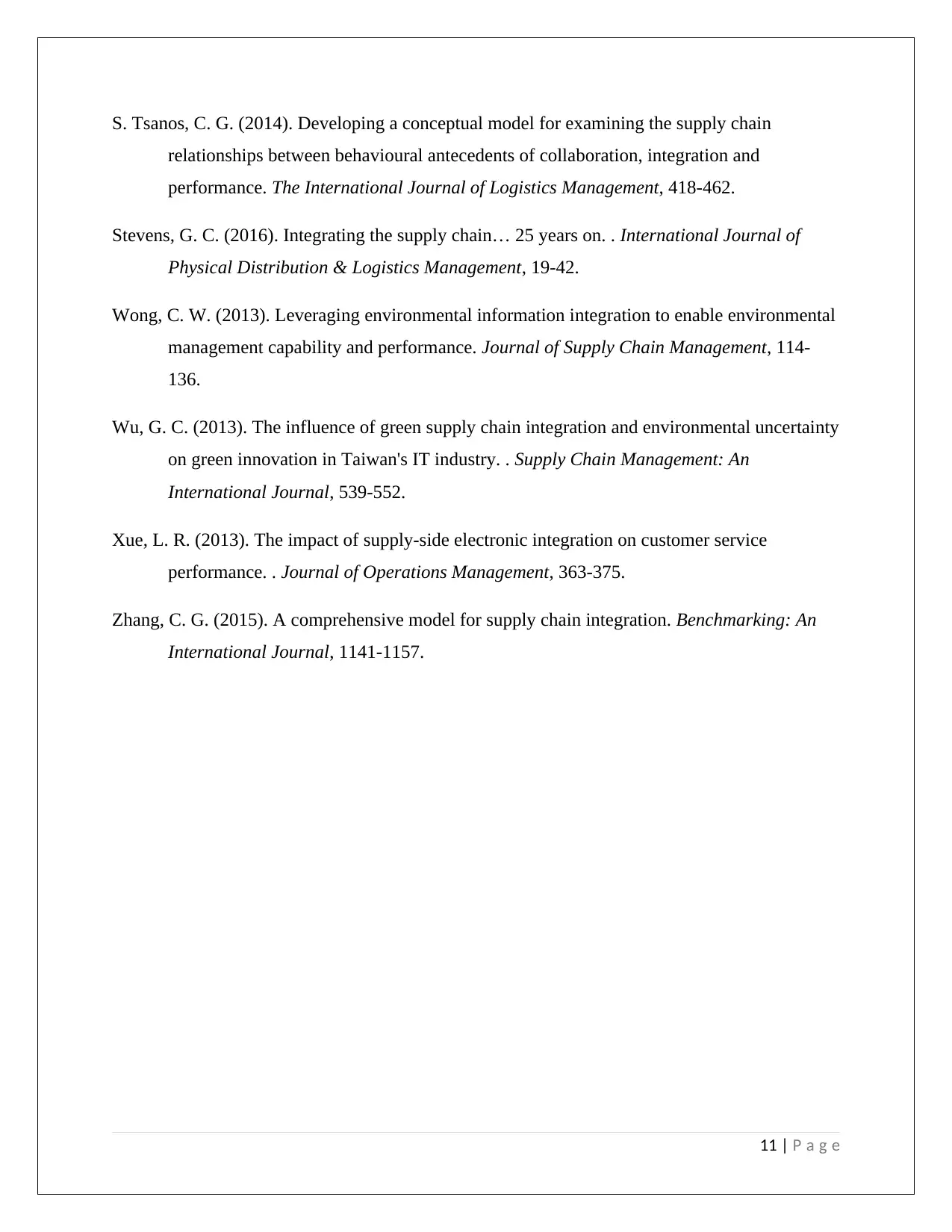
S. Tsanos, C. G. (2014). Developing a conceptual model for examining the supply chain
relationships between behavioural antecedents of collaboration, integration and
performance. The International Journal of Logistics Management, 418-462.
Stevens, G. C. (2016). Integrating the supply chain… 25 years on. . International Journal of
Physical Distribution & Logistics Management, 19-42.
Wong, C. W. (2013). Leveraging environmental information integration to enable environmental
management capability and performance. Journal of Supply Chain Management, 114-
136.
Wu, G. C. (2013). The influence of green supply chain integration and environmental uncertainty
on green innovation in Taiwan's IT industry. . Supply Chain Management: An
International Journal, 539-552.
Xue, L. R. (2013). The impact of supply-side electronic integration on customer service
performance. . Journal of Operations Management, 363-375.
Zhang, C. G. (2015). A comprehensive model for supply chain integration. Benchmarking: An
International Journal, 1141-1157.
11 | P a g e
relationships between behavioural antecedents of collaboration, integration and
performance. The International Journal of Logistics Management, 418-462.
Stevens, G. C. (2016). Integrating the supply chain… 25 years on. . International Journal of
Physical Distribution & Logistics Management, 19-42.
Wong, C. W. (2013). Leveraging environmental information integration to enable environmental
management capability and performance. Journal of Supply Chain Management, 114-
136.
Wu, G. C. (2013). The influence of green supply chain integration and environmental uncertainty
on green innovation in Taiwan's IT industry. . Supply Chain Management: An
International Journal, 539-552.
Xue, L. R. (2013). The impact of supply-side electronic integration on customer service
performance. . Journal of Operations Management, 363-375.
Zhang, C. G. (2015). A comprehensive model for supply chain integration. Benchmarking: An
International Journal, 1141-1157.
11 | P a g e

12 | P a g e
⊘ This is a preview!⊘
Do you want full access?
Subscribe today to unlock all pages.

Trusted by 1+ million students worldwide
1 out of 12
Your All-in-One AI-Powered Toolkit for Academic Success.
+13062052269
info@desklib.com
Available 24*7 on WhatsApp / Email
![[object Object]](/_next/static/media/star-bottom.7253800d.svg)
Unlock your academic potential
Copyright © 2020–2025 A2Z Services. All Rights Reserved. Developed and managed by ZUCOL.
